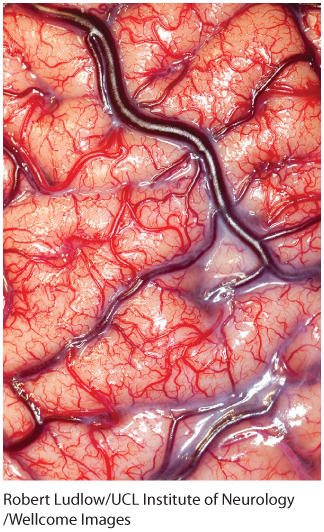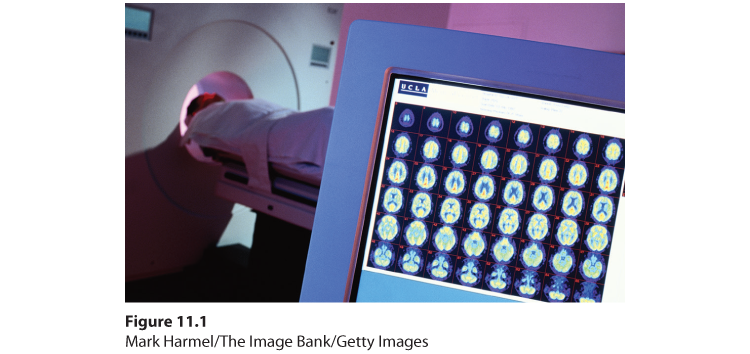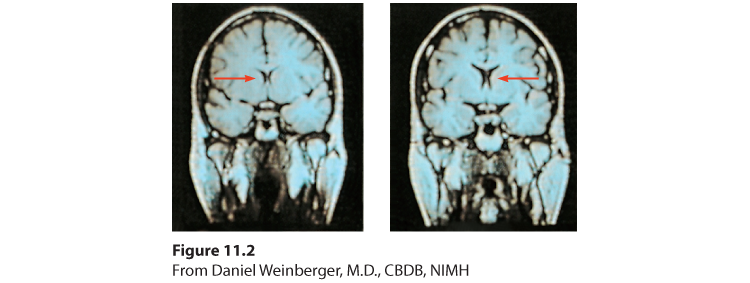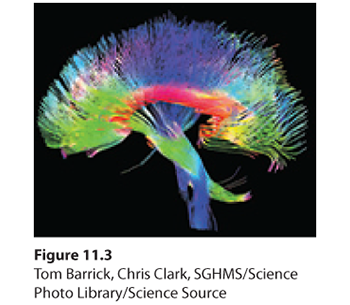The Tools of Discovery: Having Our Head Examined
For most of human history, scientists had no tools high-powered yet gentle enough to reveal a living brain’s activity. Early case studies helped localize some brain functions. Damage to one side of the brain often caused numbness or paralysis on the body’s opposite side, suggesting that the body’s right side is wired to the brain’s left side, and vice versa. Damage to the back of the brain disrupted vision, and to the left-front part of the brain produced speech difficulties. Gradually, these early explorers were mapping the brain.
“ I am a brain, Watson. The rest of me is a mere appendix.”
Sherlock Holmes, in Arthur Conan Doyle’s “The Adventure of the Mazarin Stone,” 1921

A living human brain exposed Today’s neuroscience tools enable us to “look under the hood” and glimpse the brain at work, enabling the mind.
Now, within a lifetime, a new generation of neural mapmakers is charting the known universe’s most amazing organ. Scientists can also selectively lesion (destroy) tiny clusters of normal or defective brain cells, leaving the surrounding tissue unharmed. In the laboratory, such studies have revealed, for example, that damage to one area of the hypothalamus in a rat’s brain reduces eating to the point of starvation, whereas damage in another area produces overeating.
Today’s neuroscientists can also stimulate various brain parts—electrically, chemically, or magnetically—and note the effect. Depending on the stimulated brain part, people may—to name a few examples—giggle, hear voices, turn their head, feel themselves falling, or have an out-of-body experience (Selimbeyoglu & Parvizi, 2010).
Scientists can even snoop on the messages of individual neurons. With tips small enough to detect the electrical pulse in a single neuron, modern microelectrodes can, for example, now detect exactly where the information goes in a cat’s brain when someone strokes its whisker. Researchers can also eavesdrop on the chatter of billions of neurons and can see color representations of the brain’s energy-consuming activity. Promising new tools include optogenetics, which uses light to control the activity of individual neurons (Boyden, 2014). By programming neurons to become receptive to light, researchers can examine the biological basis of fear, smell, memory, and various diseases (Drew et al., 2016; Gradinaru et al., 2009; Liu et al., 2012; Shusterman et al., 2011).
In addition to studying the brain by analyzing single cell activity—which is rather like watching a movie one pixel at a time—neuroscientists can also observe the whole brain in action. Right now, your mental activity is emitting telltale electrical, metabolic, and magnetic signals that would enable neuroscientists to observe your brain at work. Electrical activity in your brain’s billions of neurons sweeps in regular waves across its surface. An EEG (electroencephalogram) is an amplified readout of such waves. Researchers record the brain waves through a shower-cap-like hat that is filled with electrodes covered with a conductive gel. Studying an EEG of the brain’s activity is like studying a car engine by listening to its hum. With no direct access to the brain, researchers present a stimulus repeatedly and have a computer filter out brain activity unrelated to the stimulus. What remains is the electrical wave evoked by the stimulus.
A related technique, MEG (magnetoencephalography), measures magnetic fields from the brain’s natural electrical activity. To isolate the brain’s magnetic fields, researchers create special rooms that cancel out other magnetic signals, such as the Earth’s magnetic field. Participants sit underneath a head coil that resembles a hair salon hairdryer. While participants complete activities, tens of thousands of neurons create electrical pulses, which in turn create magnetic fields. The speed and strength of the magnetic fields enable researchers to understand how certain tasks influence brain activity.
“You must look into people, as well as at them,” advised Lord Chesterfield in a 1746 letter to his son. Newer neuroimaging techniques give us that Superman-like ability to see inside the living brain. For example, the CT (computed tomography) scan examines the brain by taking X-ray photographs that can reveal brain damage. The PET (positron emission tomography) scan (Figure 11.1) depicts brain activity by showing each brain area’s consumption of its chemical fuel, the sugar glucose. Active neurons gobble glucose. Our brain, though only about 2 percent of our body weight, consumes 20 percent of our calorie intake. After a person receives temporarily radioactive glucose, the PET scan can track the gamma rays released by this “food for thought” as a task is performed. Rather like weather radar showing rain activity, PET-scan “hot spots” show the most active brain areas as the person does mathematical calculations, looks at images of faces, or daydreams.

Figure 11.1 The PET scan
To obtain a PET scan, researchers inject volunteers with a low and harmless dose of a short-lived radioactive sugar. Detectors around the person’s head pick up the release of gamma rays from the sugar, which has concentrated in active brain areas. A computer then processes and translates these signals into a map of the brain at work.
In MRI (magnetic resonance imaging) brain scans, the person’s head is put in a strong magnetic field, which aligns the spinning atoms of brain molecules. Then, a radio-wave pulse momentarily disorients the atoms. When the atoms return to their normal spin, they emit signals that provide a detailed picture of soft tissues, including the brain. MRI scans have revealed a larger-than-average neural area in the left hemisphere of musicians who display perfect pitch (Schlaug et al., 1995). They have also revealed enlarged ventricles—fluid-filled brain areas (marked by the red arrows in Figure 11.2)—in some patients who have schizophrenia, a disabling psychological disorder.

Figure 11.2 MRI scan of a healthy individual (left) and a person with schizophrenia (right)
Note the enlarged ventricle, the fluid-filled brain region at the tip of the arrow in the image on the right.
A special application of MRI—fMRI (functional MRI)—can reveal the brain’s functioning as well as its structure. Where the brain is especially active, blood goes. By comparing successive MRI scans, researchers can watch as specific brain areas activate, showing increased oxygen-laden bloodflow. As a person looks at a scene, for example, the fMRI machine detects blood rushing to the back of the brain, which processes visual information. When the brain is unoccupied, blood continues to flow via a web of brain regions called the default network (Mason et al., 2007). Default network brain activity supports mind-wandering and daydreaming (Christoff et al., 2009; Smallwood & Schooler, 2015).
Such snapshots of the brain’s changing activity provide new insights into how the brain divides its labor. A mountain of recent fMRI studies suggests which brain areas are most active when people feel pain or rejection, listen to angry voices, think about scary things, feel happy, or become sexually excited. The technology enables a very crude sort of mind reading. One neuroscience team scanned 129 people’s brains as they did eight different mental tasks (such as reading, gambling, or rhyming). Later, they were able, with 80 percent accuracy, to identify which of these mental activities their participants had been doing (Poldrack et al., 2009). Other research has used the brain’s activity to predict future behavior, such as school performance, drug use, and the effectiveness of public health campaigns (Falk et al., 2012, 2016; Gabrieli et al., 2015; Table 11.1 compares these techniques).
| Name | How Does It Work? | Example |
|---|---|---|
| Electroencephalogram (EEG) | Electrodes placed on the scalp measure electrical activity in neurons. | Symptoms of depression and anxiety correlate with increased activity in the right frontal lobe, a brain area associated with behavioral withdrawal and negative emotion (Thibodeau et al., 2006). |
| Magnetoencephalography (MEG) | A head coil records magnetic fields from the brain’s natural electrical currents. | Soldiers with posttraumatic stress disorder (PTSD), compared with those who do not have PTSD, show stronger magnetic fields in the visual cortex when they view trauma-related images (Todd et al., 2015). |
| Computed tomography (CT) | X-rays of the head generate images that may locate brain damage. | Children’s brain injuries, shown in CT scans, predict impairments in their intelligence and memory processing (Königs et al., 2017). |
| Positron emission tomography (PET) | Tracks where a temporarily radioactive form of glucose goes while the brain of the person given it performs a given task. | Monkeys with an anxious temperament have brains that use more glucose in regions related to fear, memory, and expectations of reward and punishment (Fox et al., 2015). |
| Magnetic resonance imaging (MRI) | People sit or lie down in a chamber that uses magnetic fields and radio waves to provide a map of brain structure. | People with a history of violence tend to have smaller frontal lobes, especially in regions that aid moral judgment and self-control (Glenn & Raine, 2014). |
| Functional magnetic resonance imaging (fMRI) | Measures bloodflow to brain regions by comparing continuous MRI scans. | Years after surviving a near plane crash, passengers who viewed material related to their trauma showed greater activation in the brain’s fear, memory, and visual centers than when they watched footage related to the 9/11 terrorist attacks (Palombo et al., 2015). |
Researchers now seek to go beyond examining how brain regions work independently. To understand how different brain regions work together, they study brain connectivity, which can also offer clues to psychological disorders. For example, people with major depressive disorder tend to show low connectivity between brain regions involved in experiencing emotion and emotion regulation; these two types of brain regions don’t “talk” very well (Kaiser et al., 2015). This poor neural communication may help explain why people with depression often struggle to regulate their emotions (Etkin et al., 2015; Miller et al., 2015).
You’ve seen the pictures—of colorful brains with accompanying headlines, such as “your brain on music.” Hot brains make hot news (Bowers, 2016; Fine, 2010). In one study, students rated scientific explanations as more believable and interesting when they contained neuroscience (Fernandez-Duque et al., 2015). But “neuroskeptics” caution against overblown claims about any ability to predict customer preferences, detect lies, and foretell crime (Satel & Lilienfeld, 2013; Schwartz et al., 2016; Vul et al., 2009a,b). Neuromarketing, neurolaw, neuropolitics, and neurotheology are often neurohype. Imaging techniques illuminate brain structure and activity, and sometimes help us test different theories of behavior (Mather et al., 2013). But given that all human experience is brain-based, it’s no surprise that different brain areas become active when one listens to a lecture or lusts for a lover.
* * *
Today’s techniques for peering into the thinking, feeling brain are doing for psychology what the microscope did for biology and the telescope did for astronomy. From them we have learned more about the brain in the last 30 years than in the previous 30,000. And the next decade will reveal much more, as each year massive funding goes into brain research. Europe’s Human Brain Project promises $1 billion for brain computer modeling. And the $40 million Human Connectome Project seeks “neural pathways [that] will reveal much about what makes us uniquely human and what makes every person different from all others” (2013; Gorman, 2014; Smith et al., 2015). It harnesses the power of diffusion spectrum imaging, a type of MRI technology that maps long-distance brain fiber connections (Jarbo & Verstynen, 2015) (Figure 11.3). Such efforts have led to the creation of a new brain map with 100 neural centers not previously described (Glasser et al., 2016).

Figure 11.3 Beautiful brain connections
The Human Connectome Project is using cutting-edge methods to map the brain’s interconnected network of neurons. These brain maps have helped identify over 100 new neural centers (Glasser et al., 2016).
To learn about the neurosciences now is like studying world geography when Magellan explored the seas. Today’s whole-brain mapping effort has been likened to last century’s Apollo program, which landed humans on the Moon. This truly is the golden age of brain science.